CH12 - Central Nervous System
1/32
There's no tags or description
Looks like no tags are added yet.
Name | Mastery | Learn | Test | Matching | Spaced |
|---|
No study sessions yet.
33 Terms
List the four regions of an Adult Brain
Cerebral hemispheres (Cerebrum)
Diencephalon
Brain stem
Midbrain
Pons
Medulla
Cerebellum
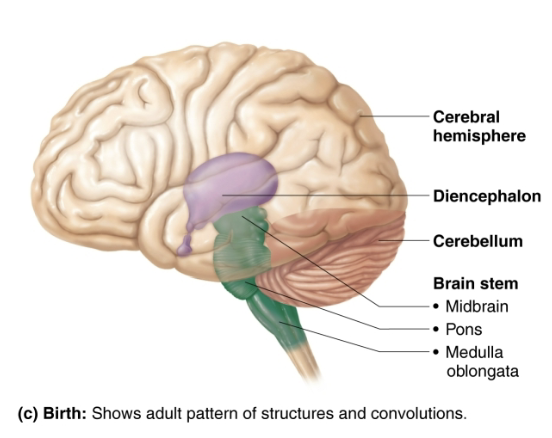
Gray Matter vs White matter
Gray matter
Short, non-myelinated neurons and cell bodies
White matter
Myelinated and non-myelinated axons
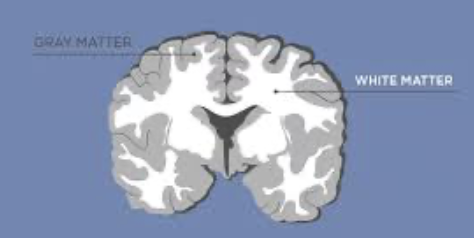
Describe the basic pattern found in CNS in regards to brain regions and organization
CNS (Brain & Spinal cord)
Central cavity surrounded by gray matter, white white matter external to gray matter
Spinal cord
Exhibits this basic pattern → however pattern changes with ascent to brainstem
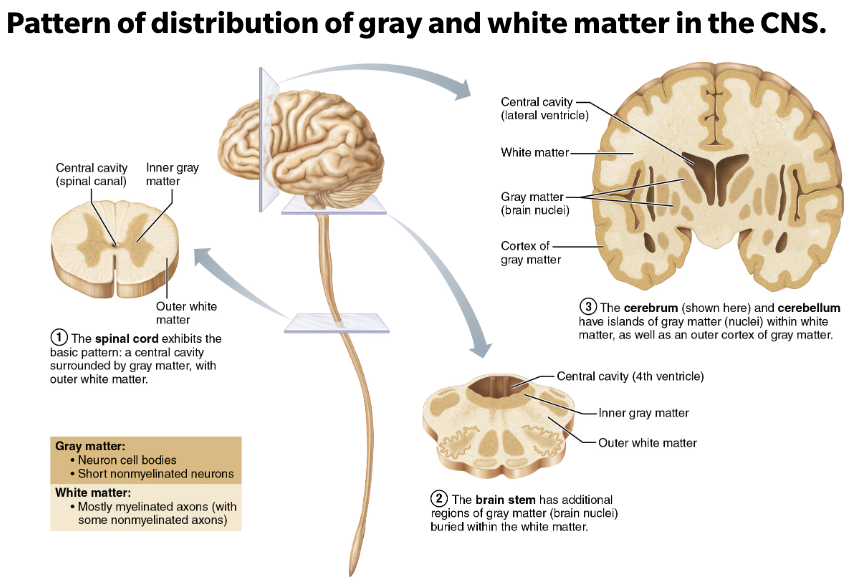
T/F: Most neuron cell bodies are located in PNS
→ False
Most neuron cell bodies are located in CNS
Nuclei: clusters of neuron cell bodies in CNS
Ganglia: clusters of neuron cell bodies in PNS
Structural and Function of Ventricles
STRUCTURE
Fluid-filled chambers that are continuous to one another and to central canal of spinal cord
Filled with cerebrospinal fluid (CSF)
Lined by ependymal cells (neuroglial cells)
Line the central cavities of the brain and spinal column
Produce cerebrospinal fluid (CSF)
Paired lateral ventricles (first and second) are large, C-shaped chambers located deep in each hemisphere
Pair is separated by membranous septum pellucidum
Third ventricle is in diencephalon
Fourth ventricle is between brain stem and connects with central canal of spinal cord
FUNCTION
Produce and secrete cerebrospinal fluid to protect and maintain your central nervous system
CSF is constantly bathing the brain and spinal column, clearing out toxins and waste products released by nerve cells
EXAMPLE
The waste product - Amyloid A-b peptide → increases the risk of Alzheimer’s disease if too much accumulates in the brain
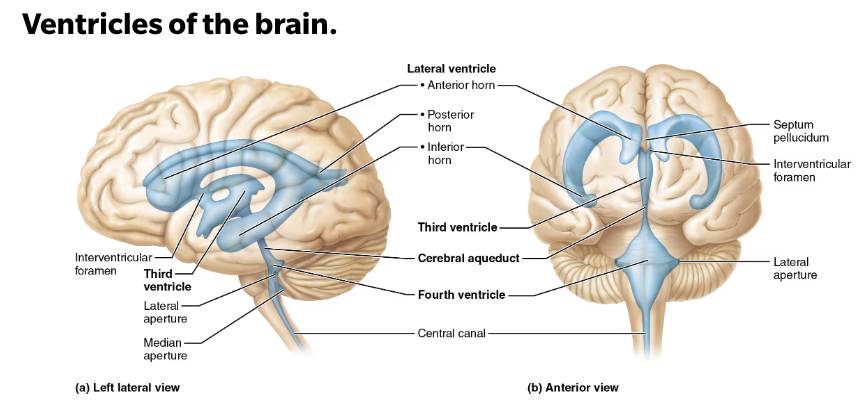
Structural and Function of Cerebral Hemispheres (Cerebrum)
Regions of an Adult Brain (1/4)
STRUCTURE
Left and right hemisphere
Accounts for 83% of brain mass
Separated by a groove, the longitudinal fissure
Each of these hemispheres has an outer layer of grey matter, the cerebral cortex
The cerebral cortex is supported by inner layer of white natter
The hemispheres are linked by the corpus callosum, a very large bundles of nerve fibers
FUNCTION
Form superior part of brain

List the major lobes of the Cerebral Hemispheres (Cerebrum)
Frontal lobe
Parietal lobe
Temporal lobe
Occipital lobe
Insular lobe
Buried under portion of temporal, parietal and frontal lobes
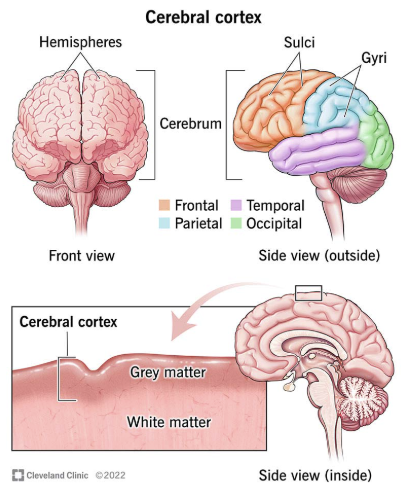
Functions of Frontal Lobe
Executive functions
Planning, organizing, problem-solving, decision-making, attention, and self-control
Motor control
Initiating and coordinating voluntary movements
Langauge
Producing and understanding speech
Emotional regulation
Controlling emotions, such as anger, fear, and sadness
Personality
Expressing personality traits and social behavior
Working memory
Holding and manipulating information in the short term
Creativity and innovation
Generating new ideas and solutions
Functions of Parietal Lobe
Somatosensory perception
Processing sensations such as touch, pain, temperature, and proprioception (body awareness)
Spatial orientation
Understanding and interpreting the position and movement of objects in space
Attention and focus
Directing attention to specific stimuli and maintaining focus
Movement planning
Initiating and coordination voluntary movements
Language processing
Contributing to the understanding and production of language
Number and calculation
Processing numerical information and performing calculations
Functions of Temporal Lobe
Auditory Processing
The primary auditory cortex, which receives and processes auditory information
Language
Understanding and producing spoken language
Memory
Hippocampus, plays a vital role in forming and storing memories
Emotion
The amygdala processes and regulates emotions, including fear, pleasure, and anger
Visual Processing
Contributes to visual processing by aiding in object recognition, face recognition, and the integration of visual information with other sensory inputs
Functions of Occipital Lobe
Receiving visual information
Receives visual information from the retina via the thalamus
Mapping visual input
It helps with spatial reasoning and visual memory
Color determination
Helps determine the color of the items you see
Depth perception
It is involved in assessing distance, size, and depth
Object and face recognition
It plays a crucial role in identifying familiar faces and objects
Motion detection
The occipital lobe is also involved in processing motion
Functions of Insular Lobe
Interception
Integrates information about the internal state of the body, including pain, temperature, and visceral sensations
Taste
It’s involved in the perception and processing of taste sensations
Emotional Awareness
Experience and recognition of emotions, including happiness, sadness, fear, disgust, and empathy
Social Cognition
The insula contributes to social decision-making, trust, and other aspects of social behavior
Self-Awareness
The insula plays a role in our sense of our own body in space and our relationship to it, and awareness of self
Addiction
Implicated in the processes of addiction, including and reward-seeking behavior
Clinical - Explain Dementia
Refers to a decline in cognitive function, including memory, thinking, and reasoning, to the point where it interferes with a person’s ability to perform daily activities
Dementia is not one specific disease, but rather a group of symptoms cause by various brain diseases
While many diseases can cause dementia, Alzheimer’s disease is the most common
Other causes include vascular dementia, Lewly body dementia, frontotemporal dementia, and Parkinson’s disease dementia
List and describe the Surface Markings on the Cerebral Hemispheres (Cerebrum)
Gyri
Ridges
Sulci
Shallow grooves
Fissures
Deep grooves
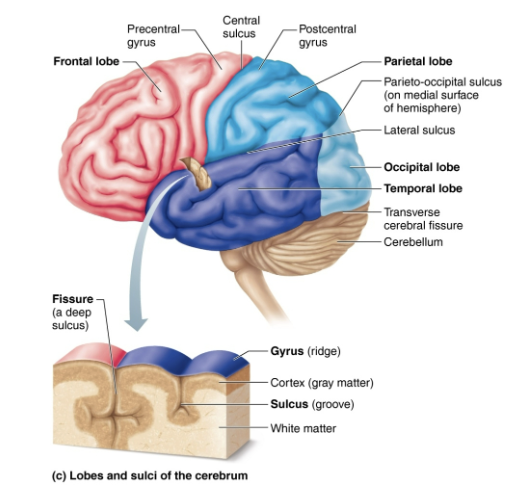
List the major Fissures of the Cerebral Hemispheres (Cereburm)
Fissure → deep grooves
Longitudinal fissure
Separates two hemispheres
Transverse cerebral fissure
Separates cerebrum and cerebellum
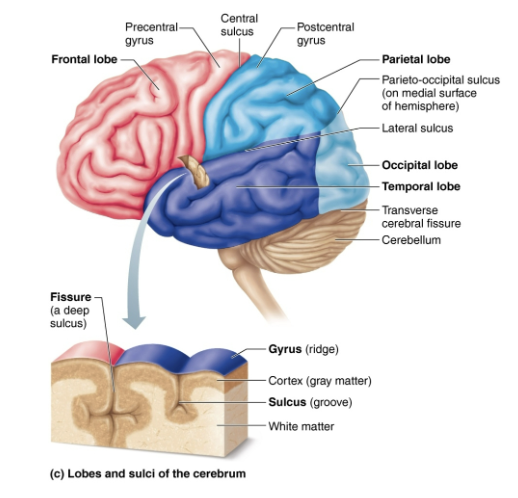
List the major Sucli that divide lobes
Central sulcus
Separates pre-central gyrus of frontal lobe and post-central gyrus of parietal lobe
Parieto-occipital sulcus
Separates occipital and parietal lobes
Lateral sulcus
Outlines temporal lobes

List the three basic regions of the Cerebral Hemisphere (Cerebrum)
Cerebral cortex of gray matter superficially
White matter internally
Basal nuclei deep within white matter

Structural and Function of Cerebral Cortex
BASIC REGIONS of the Cerebral Hemisphere (Cerebrum) (1/3)
STRUCTURE
Thin (2-4 mm) superficial layer of gray matter
Composed of neuron cell bodies, dendrites, glial cells, and blood vessels
40% of mass of brain
FUNCTION
Site of conscious mind
Awareness
Sensory perception
Voluntary motor initiation
Communication
Memory storage
Understanding

List the functional areas of the cerebral cortex
BASIC REGIONS of the Cerebral Hemisphere (Cerebrum) (1/3)
No functional area of the cortex acts alone, and conscious bheavior involves the entire cortex in one way or another
Motor areas
Control voluntary movement
Sensory areas
Conscious awareness of sensation
Association areas
Integrate diverse information
Visual areas
Auditory areas
Responsible for complex processing that goes on between the arrival of sensory input cortices and the generation of behavior
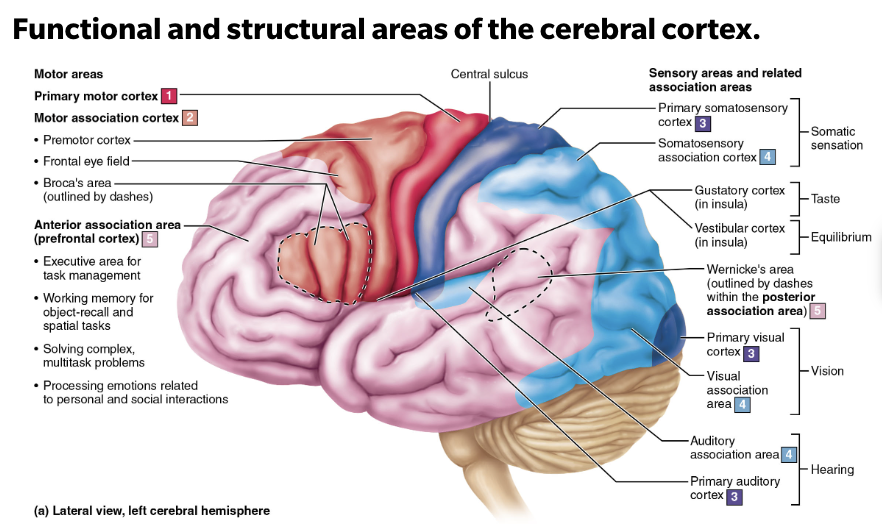
T/F: All neurons in the cortex are interneurons
→ True
Explain Cerebral Cortex Domains
Specific motor and sensory functions located in discrete cortical areas
Higher functions are spread over many areas
Shown on Functional imaging (PET and MRI)
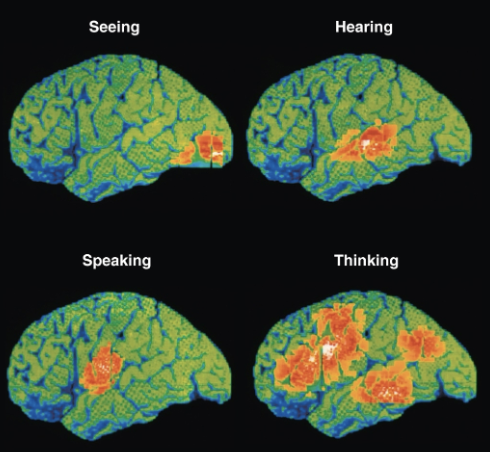
Explain Contralateral vs Lateralization of cortical function
EACH hemisphere is concerned with contralateral (opposite) side of body
Lateralization (specialization) of cortical function can occur in only ONE hemisphere
Conscious behavior involves entire cortex
Describe the location, function, structure of Motor Areas in Cerebral Cortex
Functional areas of the cerebral cortex (1/3)
LOCATION
In frontal lobe
FUNCTION
Motor areas act to control voluntary movement
STUCTURE
Primary motor cortex
Premotor cortex
Broca’s area
Frontal eye field
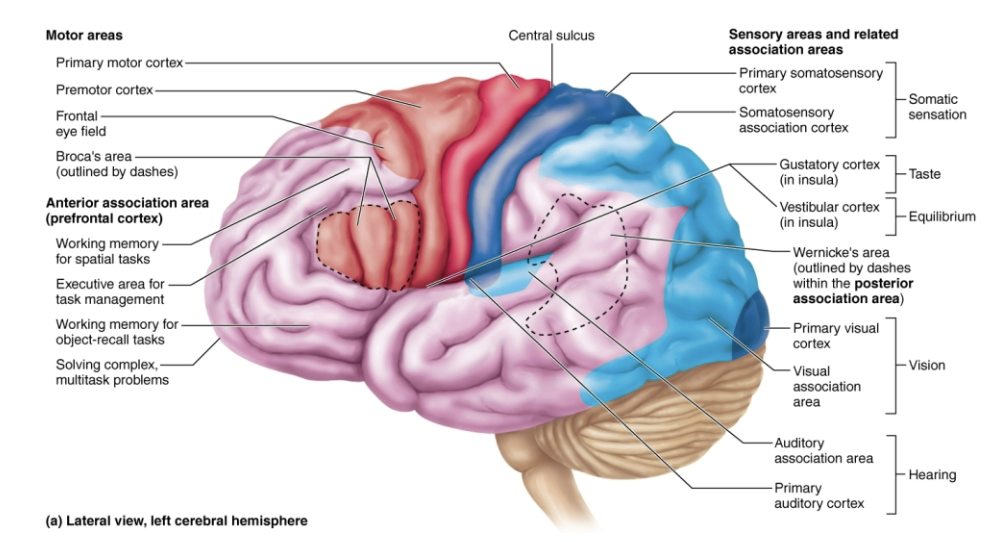
List the components of Motor Area
Functional areas of the cerebral cortex (1/3)
Motor areas in Cerebral Cortex
Primary (somatic)Motor Cortex
LOCATION
In pre central gyrus of each frontal lobe
FUNCTION
Initiating voluntary movements
Somatotopy → All muscles of body can be mapped to area on primary motor crotex
Motor homunculi → Upside-down caricatures represent contralateral motor innervation of body regions
Premotor cortex
LOCATION
Anterior to the pre-central gyrus of each frontal lobe
FUNCTION
Helps to plan and coordinate complex movements
Broca’s area
LOCATION
Anterior to inferior premotor area
Present in one hemisphere (usually left)
FUNCTION
Motor speech area that directs muscles of speech production
Active in planning speech and voluntary motor activities
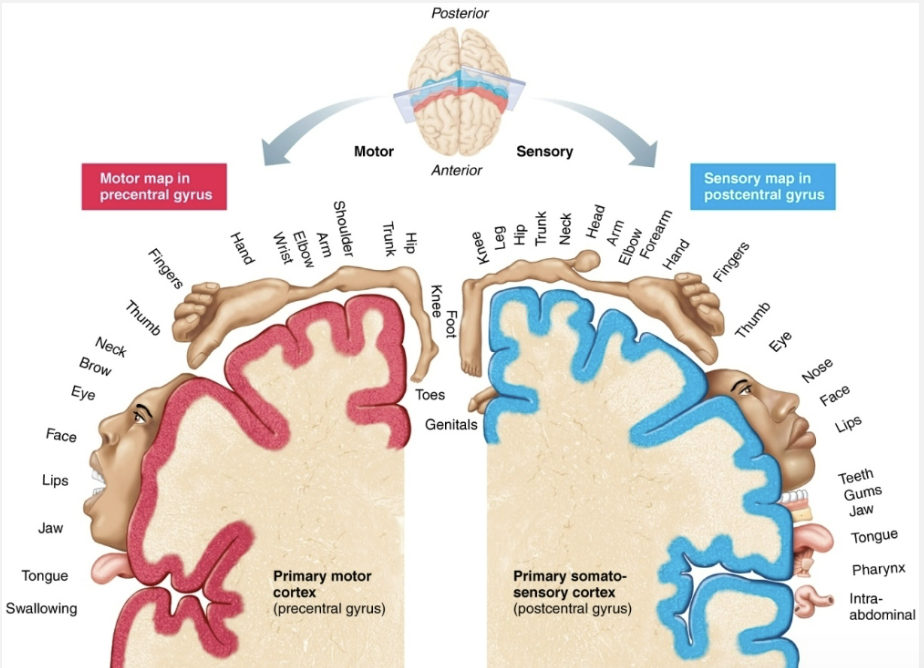
Clinical - Examples to damages to area Primary Motor Cortex
Damage to areas of primary motor cortex, as seen in a stroke, paralyzes muscles controlled by those areas
Paralysis occurs on opposite side of body from damage
Only voluntary control is lost, however, as the muscles can still contract reflexively
Clinical - Examples to damages to area Premotor Area
Muscle strength or ability to PERFORM discrete individual movements is not impaired; ONLY CONTROL over movements is lost
EX: Damage to premotor area controlling movement of fingers would still alllow fingers to move, but voluntary control needed to type would be lost
Other premotor neurons can be reprogrammed to rake over skill of damaged neurons
Would require practice, just as the initial learning process did
Describe the location, function, structure of Sensory areas in Cerebral Cortex
Functional areas of the cerebral cortex (2/3)
LOCATION
Occur in parietal, insular, temporal, and occipital lones
FUNCTION
Areas of cortex concerned with conscious awareness of sensation
STUCTURE
Primary somatosensory cortex
Location and function of Primary somatosensory cortex
Functional areas of the cerebral cortex (2/3)
Sensory areas in Cerebral Cortex
LOCATION
In postcentral gyri of parietal lobe
FUNCTION
Receives sensory information from skin and proprioceptors of skeletal muscle, joints, and tendons
Capable of spatial discrimination → identification of body region being stimulated
Somatosensory homunculus → upside-down caricatures represent contralateral sensory input from body regions
Describe the location, function, structure of Assoication areas in Cerebral Cortex
Functional areas of the cerebral cortex (3/3)
Visual association areas in Cerebral Cortex
LOCATION
Surronds primary visual cortex
FUNCTION
Uses past-visual experiences to interpret visual stimuli (color, form, or movement)
EX ability to recognize faces
Complex processing involves entire posterior half of cerebral hemispheres
STRUCTURE
Primary visual (striate)
Cortex located on extreme posterior tip of occipital lobe
Auditory association areas in Cerebral Cortex
LOCATION
Located posterior to primary auditory cortex
FUNCTION
Stores memories of sounds and permits perception of sound stimulus
STRUCTURE
Primary auditory cortex
Superior margin of temporal lobes
Interprets information from inner ear as pitch, loudness, and location
Clinical - Damage to the Primary Visual Cortex
Primary visual cortex → results in blindness
Visual association area → can see, but they do not comprehend what they are looking at
Describe the general structure function of the Cerebral White Matter
BASIC REGIONS of the Cerebral Hemisphere (Cerebrum) (2/3)
STURCURE
Second of three basic regions of cerebral hemispheres
Consists of myelinated fibers bundled into large tracts
FUNCTION
Responsible for communication between cerebral areas and between cortex and lower CNS
Classified according to direction they run”
Association
Commissural
Projection fibers
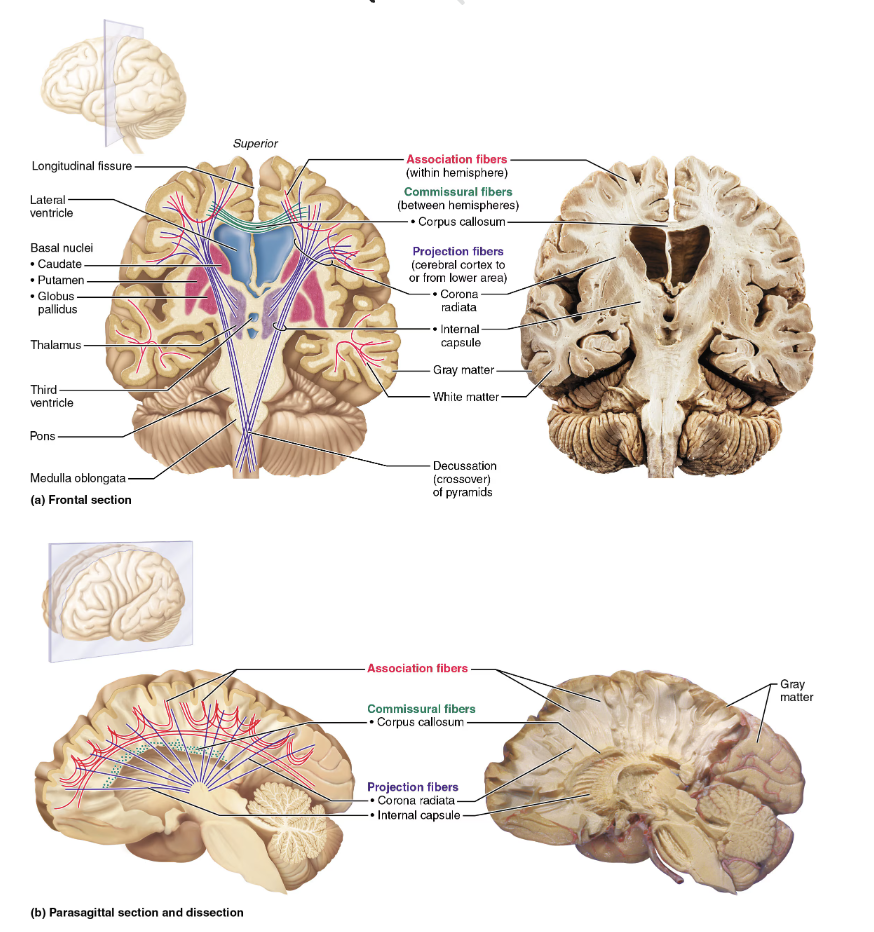
Describe the general structure function of the basal nuclei (basal ganglia)
BASIC REGIONS of the Cerebral Hemisphere (Cerebrum) (3/3)
STRUCTURE
Third of the three basic regions of cerebrum
FUNCTION
Influence muscle movements
Play role in cognition and emotion
Filter out incorrect/inappropriate responses
Clinical - Disorders of the basal nuclei
Parkinson’s disease
Brain disorder that causes unintended or uncontrollable movements, such as shaking, stiffness, and difficulty with balance and coordination
Huntington’s disease
An inherited disorder that causes nerve cells (neurons) in parts of the brain to gradually break down and die